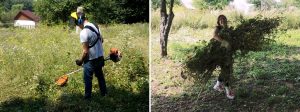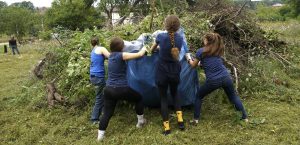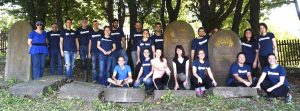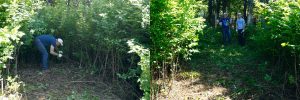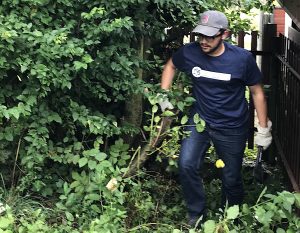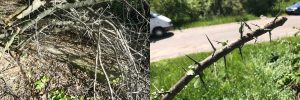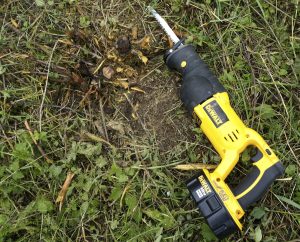![]() Ця сторінка також доступна українською.
Ця сторінка також доступна українською.
Introduction
This page summarizes and analyzes an ongoing project which progressively cleared wild vegetation from the “new” Jewish cemetery of Rohatyn in the Rohatyn raion of the Ivano-Frankivsk oblast in western Ukraine, and now maintains the site through annual volunteer work events. Project planning and progress reports are published on the project leaders’ website, together with summary information about ongoing management and costs. This project coordinates directly and indirectly with several other projects managed by the same organization, and other individuals and organizations, at the same site and other sites in western Ukraine.
This page is intended as a reference for similar projects now in the planning stages in western Ukraine or beyond. Following a brief summary of the site, the material below describes the project and reviews its effectiveness together with a listing of issues encountered, approximate project costs, and ongoing risks. Related projects both in western Ukraine and elsewhere in Europe are also briefly mentioned, for comparison. At the bottom of this page are links to project documentation and to additional reference information about the burial site and related projects.
Read the overview to case studies of selected projects at Jewish burial sites in western Ukraine.
Project Summary
Project type: Clearing of wild vegetation (heavy grass, woody shrubs and small trees, and dead tree branches) plus accumulated trash and building rubble.
Location and site type: “New” Jewish cemetery of Rohatyn, Rohatyn raion, Ivano-Frankivsk oblast, Ukraine. GPS: 49.41990, 24.60780.
Description of the site: The cemetery perimeter is nearly square in shape and of approximately 220m length, enclosing roughly 0.30 hectare of area, on a nearly-flat site.
Ownership and stakeholders: The cemetery site is owned by the municipality of Rohatyn. Stakeholders include Rohatyn Jewish Heritage (a Ukrainian heritage preservation NGO), the local civil community, foreign descendants of Rohatyn pre-war Jewish and other families, historians, and students of Jewish culture.
Official heritage status: No current national or regional registration. The site is indicated on the Rohatyn city administration general development plan and map, it is specifically recorded in Rohatyn city files as “Новий Єврейський цвинтар (поблизу вулиці Турянського)”, and the cemetery is subject to several permission agreements for care of the site assigned by the Rohatyn raion administration to the Rohatyn city administration and by the city administration to the NGO Rohatyn Jewish Heritage.
Activists working on/at the site: Rohatyn Jewish Heritage (RJH), a registered non-profit organization based in Lviv, Ukraine. Contact info.
Other projects active at the site: Digital documentation of the cemetery terrain (see ESJF 2019 survey project); digital documentation of the history of the cemetery and the Jewish community (see RJH heritage page); non-invasive GPR survey to investigate possible mass graves within the cemetery (see RJH project page); past memorials and perimeter fencing.
Project Analysis
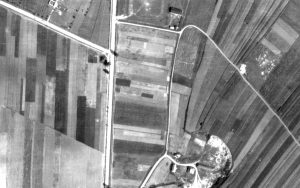
German military aerial photograph of 1944 showing the new cemetery and surroundings. Image from the
US National Archives; copy acquired by Dr. Alex Feller.
History of the site: Following legal and health concerns about over-crowding of burials at Rohatyn’s original Jewish cemetery, land was purchased by the Jewish community for a new cemetery sometime after 1910, and the cemetery was established with first burials probably in the 1920s or early 1930s. Thus, the cemetery had been in service for fewer than 25 years when German occupation in WWII destroyed the Jewish community. Some burials took place after deaths in the wartime Jewish ghetto, and while a few Jewish survivors remained in Rohatyn after the Soviet army advanced westward in 1944; a Luftwaffe wartime aerial photo of the site indicates dozens or up to a hundred grave covers and stones, mostly in the rear half of the site. Thereafter no burials took place in the new cemetery until the remains of 12 unknown individuals, presumed Jewish and died during WWII, were laid to rest in 2013; no further burials have taken place.
The new cemetery was largely stripped of its headstones during and/or after the wartime German occupation. In the decades after WWII, a local teacher aided a small number of Jewish survivors to recover and return headstones to the site; by 2010, about 30 headstones and fragments had been gathered in the cemetery. In the late 1990s, Jewish survivor and descendant groups gathered in Rohatyn to erect fences around the Jewish cemeteries and memorial steles at all the burial sites, including the new cemetery. From 2011, Rohatyn Jewish Heritage (RJH) began recovery of hundreds of additional Jewish headstone fragments from around the city and their collection at the new cemetery; in 2015, RJH moved the fragments to Rohatyn’s old Jewish cemetery, where they continue to grow in number.
Current features of/at the site: The cemetery is situated near a small suburban road about 1.5km north of the town center; a small branch road serving a few residences bounds one side, a residential house and garden is adjacent on another, open land is on a third side, and in the front the cemetery sits behind a small parking area and the service building of a woodworking shop.The cemetery is fenced and gated with low metal pickets; the fence (from the late 1990s) is decaying but still completely surrounds the cemetery. A handful of large sandstone matzevot stand near the east edge of the cemetery; a few other large headstones and large fragments lie on the cemetery ground, all except for one also near the east fence, and elsewhere a few large headstone fragments were discovered just under the ground surface during the GPR survey. The large stone memorial monument stands on a wide base near the center rear of the cemetery, and the small composite memorial for the 12 unknown dead stands on a base near the center front. Very tall trees line the east fence inside the cemetery, and a few large trees stand at or near the west fence.
Details of the project: Prior to 2017, maintenance of the cemetery was performed by the Rohatyn city office on an occasional (every few years) basis, as for all cemeteries within the city; city clearing methods were mostly limited to burning of grass.
From 2017, RJH began conducting volunteer clearing events at the new Jewish cemetery once or twice per year, for one to two days each time, with 7 to 20 volunteers of varying skill levels, and a growing number of hand and power tools. Due to the needs of other projects, the labor applied to the new cemetery clearing work varied from about 20 person-days in 2017, to 7 person-days in 2018, to about 40 person-days in 2019.
Clearing work in the first two years focused on removing large masses of wild vegetation with hand tools and with a few light-duty motor tools; most of the volunteers worked to haul and pile cut branches and vines for later disposal. In the third year, increased skills and more motor tools of several types enabled clearing grasses and light brush much faster, and old and woody shrubs were cleared to the fence lines for the first time. Smaller work events with three or four volunteers each also began focusing motor saws on residual stumps of large shrubs and small trees so that lighter string trimmers can quickly clear grass and other new growth to the ground.
In addition to clearing new annual vegetation growth and removing accumulated garbage, future project work is expected to continue the focus on residual stumps, conditioning the site to gradually reduce the effort needed to clear normal vegetation.
Issues encountered in the project: A lack of tools and skilled labor made early clearing efforts inefficient. The lack of attention the cemetery had received prior to 2017 allowed woody shrubs and briar to form dense and thorny thickets in two corners of the site, and heavy brush to grow out of tall grasses over the entire site; fully clearing the thickets and leveling the brush took three years of work.
Inexperience in the first year meant that most of the small woody plants and trees were cut at several centimeters above the ground level, leaving a trip hazard and a live root from which new shoots appear every year; the stumps are too strong to be cut by motorized string trimmers, and they easily break the string when volunteers attempt to clear grass around them. Thus the stumps must be individually cut with saws during spring and late autumn when growth is slow but there is no masking snow on the ground.
Disposal of cut green waste requires arrangements with truck drivers or the city maintenance crew; too much waste is produced to allow burning in most years.
A small number of highly poisonous Sosnowski’s hogweed (Heracleum sosnowskyi) plus milder irritants such as stinging nettle require continuous attention and care when working in the cemetery.
Project costs, one-time and sustaining: As noted in the guide portion of this website, costs for vegetation clearing projects can be quite variable depending on the condition of the cemetery at the time of work, the availability of skilled labor and tools, and other factors. For this project, with zero-cost volunteer labor, costs during the first year were low, approximately US$350 total for a small number of hand tools, fuel and oil for two borrowed machine tools, work gloves and lunches for the volunteers, and transportation from Lviv. In the second year, two additional motor tools and eight hand tools plus safety equipment were purchased; together with the averaged cost of those tools over their life (distributed across their use at all sites), again with only volunteer labor, total costs for similar purposes were about US$320.
For the more significant clearing work in the third year, including the addition and averaging of four more motor tools, plus overnight in-town lodging and meals for many more volunteers, and a one-time payment to remove piled cut vegetation from the past two years, total costs for the new cemetery project alone were about US$1020.
Tool costs are expected to continue at the same averaged rate as tools wear out and are replaced; volunteer expenses may be similar or lower, if the conditioning work succeeds in retarding the growth of heavy shrubs and small trees. Typically, around 10% of the total costs of each work day in the cemetery is spent on personal protection and safety equipment, e.g. work gloves, goggles or face masks for motor tool users, and insect repellent.
Current risks to preservation: In western Ukraine, vegetation grows rapidly throughout the warm months of the year, so maintenance of the site two or more times per year is required to prevent woody shrubs from re-establishing and interfering with access. No other risks are apparent, apart from ordinary weathering and accumulating garbage.
Related projects in western Ukraine: The Lviv Volunteer Center (LVC) conducts Jewish cemetery and mass grave clearing and maintenance projects at regional sites every year, including a large international volunteer event; in addition to joining work in Rohatyn, past sites have included Staryi Sambir plus Drohobych and Boryslav (all in Lviv oblast). In addition to work at the new cemetery described here, Rohatyn Jewish Heritage (RJH) also manages a project at the old Jewish cemetery in Rohatyn, and has worked with the LVC at other sites such as Kalush (Ivano-Frankivsk oblast). ESJF European Jewish Cemeteries Initiative manages cemetery fencing projects in western Ukraine and elsewhere; some projects such as Kuzmino (Zakarpattia oblast) include clearing as an integral step.
Related projects outside western Ukraine: In Poland, the US Christian non-profit charity organization The Matzevah Foundation (TMF) conducts annual volunteer events clearing Jewish cemeteries, at typically 5 to 10 locations; in 2019, they continued work in Częstochowa, Krośniewice, Krzepice, Oświęcim, and Przerośl. TMF also provided hands-on training to RJH during volunteer events in Nasielsk, Poland and in Rohatyn. Filtered searches of news articles on the web portal Jewish Heritage Europe return many clearing project reports at Jewish cemeteries around Europe; among those are projects at the Kozma street cemetery in Budapest, Hungary, at Beshenkovichi, Belarus, and at Tuzla, Bosnia and Herzegovina.

A panorama of Rohatyn’s new Jewish cemetery, after project work was completed in August 2019. Photo © RJH.
References
- Jewish Cemeteries of Rohatyn – cemetery history and heritage with photos, maps and status by Rohatyn Jewish Heritage (RJH)
- New Jewish Cemetery Rehabilitation Project – overall project plans and status at the site by Rohatyn Jewish Heritage (RJH)
- RJH News articles on new Jewish cemetery clearing work – May 2017, July 2018, May 2019, and August 2019, by Rohatyn Jewish Heritage (RJH)
- RJH Annual Reports for 2017, 2018 and 2019 – includes project cost information, by Rohatyn Jewish Heritage (RJH)
- Rohatyn Mass Grave Survey – 2017 non-invasive GPR survey at three sites including the new cemetery by Rohatyn Jewish Heritage (RJH)
- Finally Laid to Rest and Remembered – news article summarizing the 2013 burial and 2015 memorial of human remains in the new Jewish cemetery, by Rohatyn Jewish Heritage (RJH)
- Rohatyn New Jewish Cemetery – terrain measurements and survey notes by ESJF European Jewish Cemeteries Initiative
- Rogatin – the cemeteries and mass grave research and survey page on the website of the IAJGS International Jewish Cemetery Project
- New Jewish Cemetery in Rohatyn – cemetery survey page with photos by the Center for Jewish Art
- It’s All Gone, It’s Still There – a photo and text essay from 2013 covering the Rohatyn new Jewish cemetery and cemeteries in Lviv and Ivano-Frankivsk, from Christian Herrmann’s Vanished World blog site

